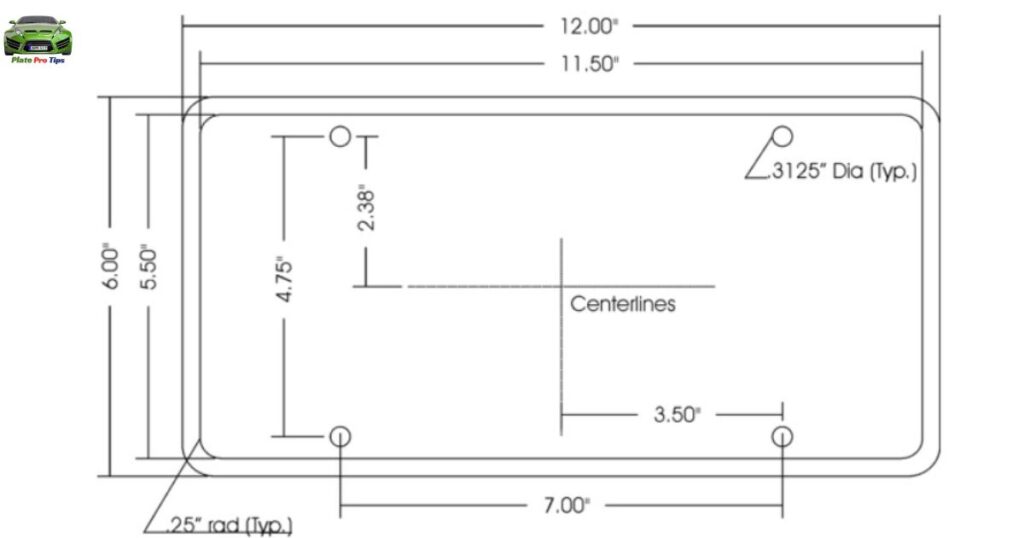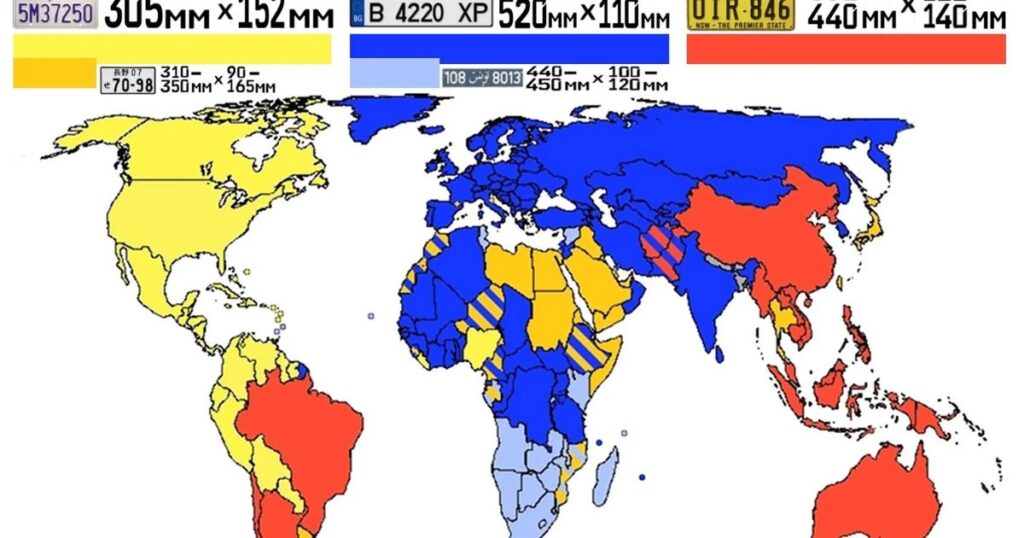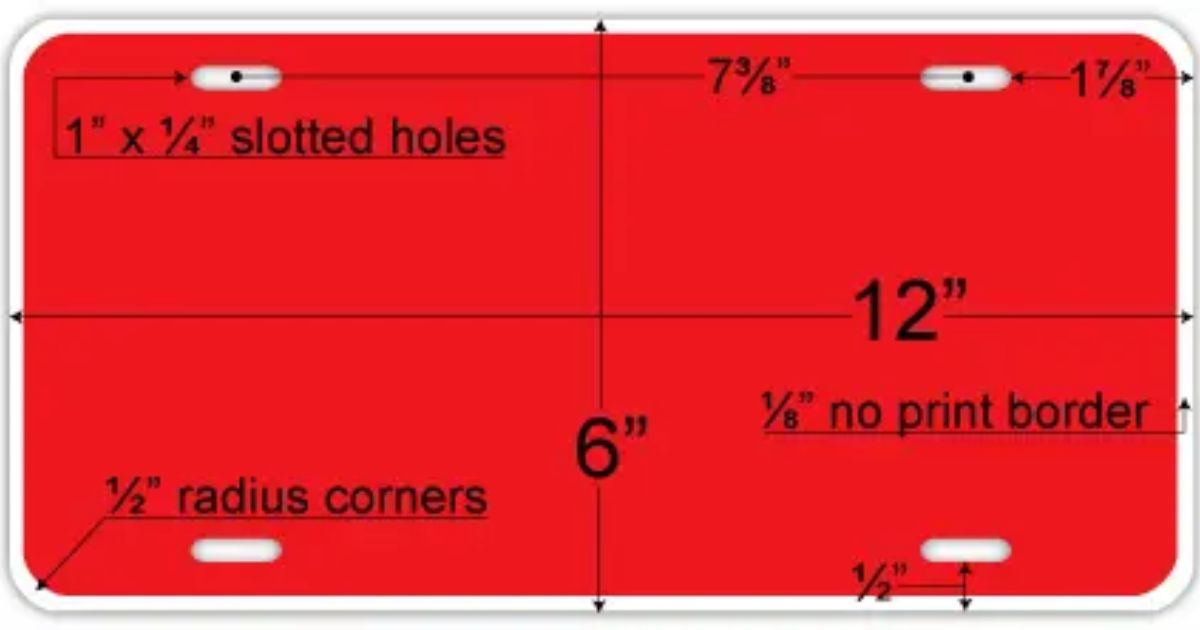A license plate is a small metal or plastic plate affixed to a vehicle, displaying a unique alphanumeric code. The standard size for a license plate is typically 12 inches in length and 6 inches in height. These dimensions may vary slightly depending on the country or state regulations. License plates serve as identification for vehicles and are issued by government authorities.
Discover the surprisingly simple world of license plates? Ever wondered about the perfect dimensions that make up these ubiquitous tags on your vehicle? Dive into the realm of license plate sizes, where a mere 12 inches in length and 6 inches in height define their identity. Curiosity piqued? Uncover the fascinating details and find out more about the tiny metal or plastic plates that uniquely identify your ride! Explore the world of license plates now.
The size of a license plate is typically 12 inches in length and 6 inches in height. These standardized dimensions ensure uniformity and easy identification of vehicles. Variations may exist based on specific country or state regulations. License plates play a crucial role in identifying and registering vehicles on the road.
Understanding License Plate Dimensions

License plate dimensions are standardized measurements that play a crucial role in vehicle identification. Across various regions, the standard size for a license plate is typically 12 inches in length and 6 inches in height. This uniformity ensures consistency in the design and display of license plates, making it easier for authorities and the public to identify and register vehicles on the road. If you ever need to Change License Plate Light, it’s essential to follow the guidelines and specifications set for license plates to maintain visibility and compliance with regulations.
Delving deeper into license plate dimensions reveals the impact of size on the overall functionality of these plates. The standardized measurements not only contribute to easy identification but also facilitate streamlined registration processes. Adherence to size regulations is a critical aspect of legal compliance, emphasizing the significance of understanding license plate dimensions in the broader context of vehicle identification and registration.
Standard Sizes Across Regions

License plate dimensions serve as a standardized framework for vehicle identification across various regions. The typical size, measuring 12 inches in length and 6 inches in height, is widely accepted as a global standard, ensuring consistency in the appearance of license plates. However, it’s essential to recognize that these measurements may vary from one region to another due to country or state regulations.
Exploring the Materials: Metal vs. Plastic License Plates
Deviation from the standard license plate dimensions can be attributed to the specific regulations set by countries and states. While the typical size is 12 inches in length and 6 inches in height, various regions may establish their own unique requirements. For instance, some countries might opt for larger or smaller dimensions based on factors like visibility, design preferences, or technological considerations.
Why Size Matters: The Significance of License Plates
The size of license plates holds significant importance in the realm of vehicle identification and registration. The standardized dimensions, typically 12 inches in length and 6 inches in height, play a crucial role in facilitating easy recognition of vehicles on the road. Uniformity in size ensures that license plates are visible and easily readable, contributing to efficient law enforcement, traffic management, and public safety.
Moreover, the significance of license plate size extends beyond mere visual recognition. Standard dimensions contribute to streamlined manufacturing processes, making it cost-effective for production facilities to create license plates that fit within the established framework. This not only simplifies the production and distribution logistics but also aids in maintaining a consistent aesthetic across the automotive landscape.
Easy Identification on the Road
The standardized size of license plates, typically measuring 12 inches in length and 6 inches in height, plays a pivotal role in ensuring easy identification of vehicles on the road. This universal dimension allows for quick visual recognition, aiding both law enforcement and fellow drivers in distinguishing one vehicle from another.
Ensuring Uniformity in Vehicle Registration

The standardized dimensions of license plates, typically set at 12 inches in length and 6 inches in height, are instrumental in ensuring uniformity in vehicle registration processes. This consistency in size allows for a streamlined and efficient registration system, enabling authorities to manage and organize vehicle information effectively.
Exploring the Materials: Metal vs. Plastic License Plates
The choice of materials for license plates, whether metal or plastic, adds an interesting dimension to the exploration of license plate features. Metal license plates, often made of aluminum or other durable alloys, are favored for their sturdiness and longevity. These plates are known to withstand various weather conditions and maintain their structural integrity over time.
When exploring license plate materials, factors such as durability, cost, and environmental impact come into play. Metal plates, while robust, may be heavier and more expensive to produce. Plastic plates, being lighter and potentially more cost-effective, contribute to sustainability efforts by reducing the use of metals in production.
Durability and Longevity
Durability and longevity are key considerations when evaluating license plate materials. Metal license plates, often crafted from aluminum or other alloys, are known for their robustness and ability to withstand various environmental challenges. Resistant to rust and corrosion, metal plates exhibit a durability that allows them to endure exposure to diverse weather conditions, contributing to their long lifespan on vehicles.
Environmental Impact and Cost Considerations
When considering license plate materials, the environmental impact and cost considerations are significant factors that come into play. Metal license plates, while durable and resistant to environmental factors, may involve a higher production cost due to the extraction and processing of metals. Additionally, the manufacturing of metal plates can contribute to a larger carbon footprint compared to alternative materials.
Size Evolution: Historical Changes in License Plate Dimensions
The evolution of license plate sizes over the years reflects the dynamic nature of vehicle identification standards. Historically, license plates have undergone changes in dimensions driven by technological advancements, design preferences, and regulatory updates. Early license plates were often larger and varied widely in shape, but as standardization efforts gained momentum, dimensions started to align.
The size evolution of license plates not only reflects changes in aesthetics and manufacturing capabilities but also highlights the adaptability of regulatory frameworks to accommodate advancements in vehicle technology. As license plates evolved, they continued to serve as a crucial tool for law enforcement, vehicle registration, and public safety.
Shifts in Size Over the Years
The dimensions of license plates have undergone noteworthy shifts over the years, reflecting changing trends and regulatory considerations. In the early days of automobile history, license plates displayed considerable variability in size and shape. As transportation systems evolved and the need for standardized identification grew, there was a discernible shift towards more consistent dimensions.
Technological Advancements and their Influence
Technological advancements have played a significant role in shaping the size and design of license plates over the years. As manufacturing processes evolved, the ability to produce plates with greater precision and efficiency improved. Technological innovations allowed for the creation of materials that are both durable and lightweight, influencing the shift from heavier metal plates to more versatile plastic alternatives.
Beyond Size: The Functionality of License Plates
Beyond their standardized dimensions, license plates serve multiple functions crucial to the functioning of modern transportation systems. Primarily, license plates act as unique identifiers for vehicles, facilitating quick and accurate registration by authorities. This identification is essential for law enforcement, enabling them to monitor traffic, identify stolen vehicles, and enforce road safety regulations effectively.
Moreover, advancements in technology have expanded the functionality of license plates. Some regions have adopted electronic license plates with features like digital displays or RFID technology. These innovations offer opportunities for dynamic information display, such as changing registration numbers for added security or displaying relevant messages.
Legal Requirements and Compliance

License plates are more than just identifiers; they are essential components of legal compliance in the realm of vehicle ownership and operation. Legal requirements for license plates vary by region but generally include displaying a valid plate with the correct dimensions on the front and rear of the vehicle. Compliance with these regulations ensures that vehicles are properly registered and traceable, aiding law enforcement in maintaining public safety.
Innovations in License Plate Design and Technology
Recent years have witnessed exciting innovations in license plate design and technology, transforming these traditional identifiers into dynamic elements of modern transportation systems. Digital license plates, equipped with electronic displays, have emerged in some regions, allowing for real-time updates and customization.
FAQ’S
What is the standard size of a license plate?
The standard size for a license plate is typically 12 inches in length and 6 inches in height.
Do license plates have the same size worldwide?
No, license plate sizes can vary between countries; however, many adhere to the standard 12×6-inch dimensions.
Are there different license plate sizes in different U.S. states?
Yes, license plate sizes can vary between U.S. states as each state may have its own size requirements or design variations.
Can license plate sizes change over time?
Yes, license plate sizes may change over time due to regulatory updates, design trends, or technological advancements.
Are there specialty license plates with unique sizes?
While the core dimensions remain consistent, some regions offer specialty license plates with unique designs or additional elements incorporated into the overall size.
Conclusion
In conclusion, the standardized dimensions of license plates, typically 12 inches in length and 6 inches in height, play a vital role in ensuring uniformity and efficiency in vehicle identification. These dimensions, though not entirely universal, offer a widely accepted standard that aids law enforcement, registration authorities, and the public in recognizing and distinguishing vehicles on the road.
The historical shifts and innovations in license plate design and technology reflect the dynamic nature of transportation systems, highlighting the adaptability of these identifiers to regulatory changes and technological advancements.

I’m Shoaib, a passionate blogger with 5 years of experience. I love writing about tech. My goal is to share useful information and insights with you. Explore my website to discover exciting content on various topics!




